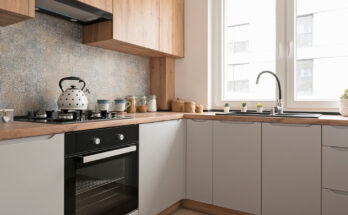The Best Way To Brighten Up A Dark Kitchen, According To HGTV’s Mike Holmes
We may receive a commission on purchases made from links.
Kitchens are one of the most utilized spaces in the home, but thanks to all the edges, nooks, and crannies, they can lean dark without the proper lighting. Figuring out the best type of lighting to use in your kitchen can be overwhelming to say the least. To make it easy, Mike Holmes, host of HGTV’s “Holmes on Homes,” recommends a layered lighting approach to brighten up a dark kitchen.
“The best way to light your space is to use a combination of different lights,” Holmes shares on his website, Make It Right. “Different lighting sources will allow you to create functional and aesthetically pleasing space that suits today’s busy kitchens.” He suggests having three minimum light source types to brighten a dark kitchen: overhead, accent, and task lighting. Overhead lighting acts as an all-purpose brightener, accent lighting highlights specific areas or elements, and task lights make it easy to see what you’re doing, like chopping carrots or reading through that recipe.
How to use the three types of lighting to brighten a dark kitchen
When you’re planning your kitchen’s lighting layout, it’s important to account for all three lighting sources. First, flip on the overhead light. Is it sufficient to see and move safely in the space? If not, consider adding more overhead lighting. Next, notice where you do your prep work, especially if you’re upgrading the lighting in an existing kitchen. Knowing your go-to spots to meal plan or prep dinner will help you identify where you need more focused light. Then, step back and assess your kitchen. Where could you add some accent lighting to brighten the space and atmosphere? Think wall sconces, uplights, or even over-cabinet lighting. Finally, assess the natural light in your kitchen. Knowing where it falls during the day can help you appropriately brighten a dark kitchen after sunset.
Now that you know where you want light and where it’s lacking, consider what kind of light fixtures to add. Pendant lights are a great overhead option. They can be easily rotated out when you want to switch up décor, and can act as both task lighting and all-purpose lighting. For task lighting, under-cabinet lighting is great to add in during construction to minimize wires, but if that’s not possible, rechargeable LED lights like MCGOR Under Cabinet Lighting will do the trick. Recessed lighting, like Meconard Ultra-Thin LED Recessed Ceiling Light, can help brighten the overall space. Just make sure to space them out at least four feet for maximum light distribution.
The top thing to keep in mind to pull your kitchen lighting together
Different areas in your kitchen need different light and therefore, different light bulbs. Think about it: You probably want a bright white light during meal prep, but not so much in the breakfast nook. As a general rule of thumb, use cooler lights in work areas and warmer lights to create atmosphere. Not sure how to tell which bulb is which tone? Check the Kelvin rating on the bulb box. The lower the number, the warmer the light.
However, a quick stroll down your hardware store’s light bulb aisle will show there are more choices to make than just the Kelvin rating. One of the biggest choices? The type of light bulb. There are multiple options, from halogen to fluorescent bulbs, but Holmes recommends using LED. Why? “LEDs can be used on dimmers and use about 20 percent less energy,” he continues in the same post, adding, “LEDs may cost more, but it’s worth it. The money you save on energy … doesn’t compare. When you switch to LEDs, you are helping the environment, your home, and your wallet.”
Finally, to create cohesive lighting across the kitchen, Holmes recommends sticking to a single brand when it comes to choosing your bulbs. Does this feel a bit over the top? Maybe, but a major lighting mistake that makes your kitchen look dull and tired is not using the right colored light bulbs. Using bulbs created by the same brand will ensure the light colors complement each other perfectly, turning your previously-dark kitchen into a warm, welcoming space.



